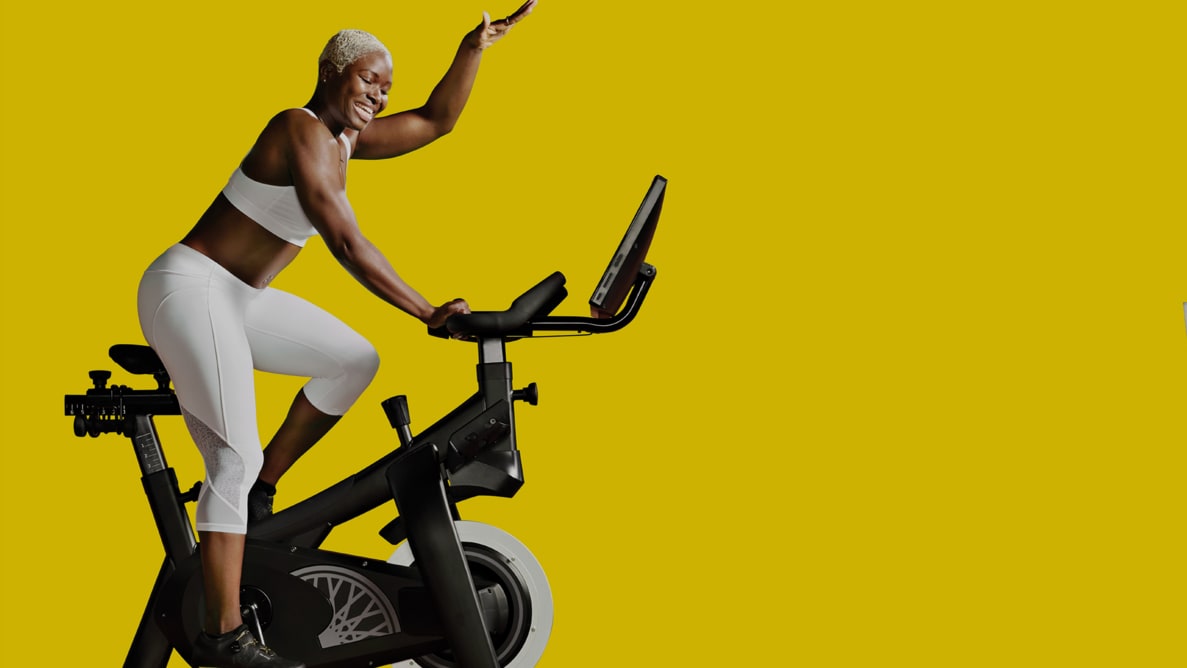Pros
-
Sturdy and easy to adjust to fit the broadest array of body sizes
-
Great instructors and dance club-like classes
-
Can stream Netflix and Disney+ from the bike
Cons
-
Makes noise when pedaling
-
Can only access biking classes from bike screen
-
Limited performance metrics
What is the SoulCycle bike?
I’m not exactly sure when it happened, but at some point in the early 2010s, I became aware of a brand called “SoulCycle.” I was a college student in North Carolina at the time, so I was a little late to a game that many professional urbanites were already in on—SoulCycle was founded in 2006 in the Upper West Side of Manhattan (though, of course, any real fan will know that it wasn’t until the creators set up a second studio in a barn in the Hamptons that the brand really took off.)
In any case, I soon learned that SoulCycle was a studio cycling class that seemed to pull from nightclubs and self-help seminars in equal measure—each class complete with mood lighting, thrumming dance-pop remixes so loud you could feel them in your bones, and instructors who would push participants to their limits, both physically and mentally (sometimes to not-so-great effect.)
The idea is that SoulCycle is an experience, not just an exercise class. In an in-studio class, maybe you’d be so overcome by the combination of endorphins and instructor encouragement that you’d cry. Maybe the instructor would. No matter what, they’d definitely light a $42 citrus-scented Jonathan Adler x SoulCycle candle at the end of class, and you could peruse the customized Le Labo toiletries to freshen up before leaving the studio.
The bike, released in March 2020, is an attempt to replicate this experience—or at least the instruction and pedaling—at home. Like its closest rival, the Peloton bike, it has an attached screen that allows owners to stream live classes taught by SoulCycle instructors. (And, unlike the Peloton, it’s also able to stream content from Disney+ and Netflix—more details on how that works below.) Also like Peloton, you must opt into its $40 monthly app, Variis by Equinox (SoulCycle's parent company), to access the classes. When you buy the bike, you’re required to subscribe to the app for a year, but if you’re already a member of an Equinox health club, the app is included with your membership fee. In addition to cycling classes, the Variis app gives you access to off-bike exercise classes, including yoga, cardio, strength training, outdoor running, and more.
What is it like to use the SoulCycle bike?
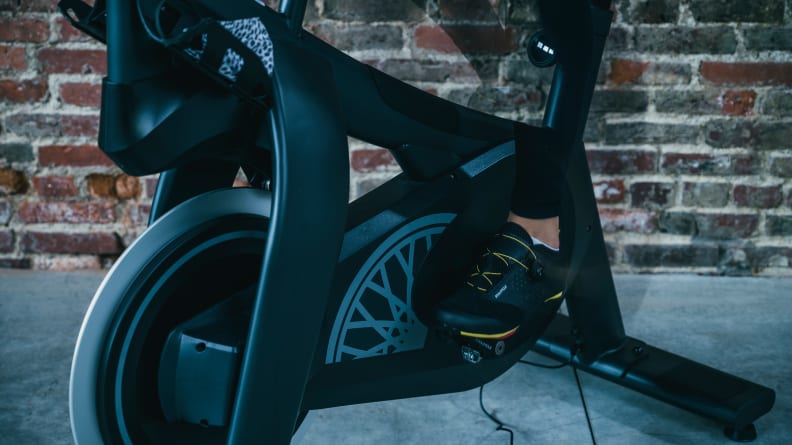
SoulCycle's at-home bike looks a lot like the ones you'd see in class.
If you’ve ever gone to a SoulCycle class, you’ll recognize the bike. It’s not the exact same one you’d see in a studio—this one has a wider base, adjustable feet, a steel frame instead of an aluminum one and, obviously, a 21.5-inch screen—but it has the same overall look. It’s adjustable to fit riders between 4 feet 10 inches and 6 feet 10 inches tall and can support riders of up to 350 pounds. Like Peloton, you may add as many user accounts to the bike as you like (and sharing the bike makes its purchase much more cost-effective). And, like the studio bike, its pedals require SPD or LOOK Delta cleats, so you must buy a pair to ride it, either from SoulCycle (at a cost of $215) or elsewhere. The classic Soul classes include a five-minute arms section with light dumbbells (usually two or three pounds). Weights are not included with the bike, but not all of the at-home bike’s classes require weights, and the lighter weight is easy enough to DIY with water bottles or soup cans. Still, you may want to purchase your own dumbbells or other indoor-cycling accessories to optimize your experience.
The tablet’s homescreen shows you bike classes you can take on demand and a schedule of the live classes for the day. Because it’s a newer product, the offerings are not as vast as some other connected bikes, but there are more than 100 on-demand classes that range between 20 and 60 minutes, and about seven live cycling classes every day. The live classes have a leaderboard—usually with about 100 people on the list—and instructors give first-name shoutouts to participants in real time to keep up the motivation. Because the class size is smaller than, say, Peloton (which usually has thousands of people in each class), your chances of getting a shoutout are higher.
In general, SoulCycle’s workout style is focused on how you feel and connect with the music during the workout, as opposed to how many calories you burn or how fast or hard you pedal. The only metrics you see on the screen are your cadence, “power” (a number based on your resistance and speed), and distance. Because there’s no tangible metric for resistance, it can be a little confusing when the instructor tells you to adjust your resistance but you can’t see an exact number on the screen, making it feel like guesswork. SoulCycle’s classes also call for on-bike choreography to the beat, such as doing push-ups on the handlebars and performing “tap-backs,” which involve getting up from the saddle, curling your abs, gripping the handlebars, and pulling your whole body back so your lower half flies over the saddle.
When you finish the class, you see the “miles” you biked and your overall power score, plus a number that reflects the percentage of the class you stayed on beat with the music but, again, no calorie-burn estimate, which is how basically every other bike measures a “successful” workout. Still, once I got used to its absence, I didn’t miss it. I felt sweaty, invigorated, and like I’d gotten a great workout after each class.
What are the best parts about the SoulCycle bike?
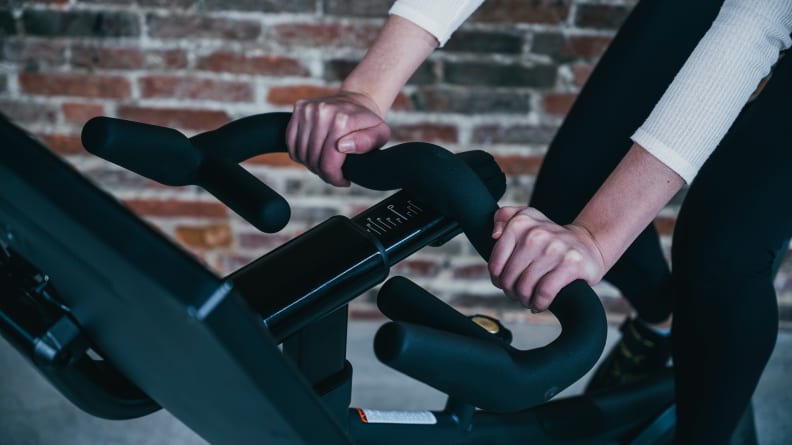
The bike's handlebars move fore and aft, so it's easy to find the right fit.
A lot of exercise bikes can feel rickety, especially when you pedal at a high intensity. Not the SoulCycle bike. It was the most solid-feeling of all the bikes I tested, with a 350-pound weight limit—one of the higher weight limits for bikes; as a comparison, Peloton’s limit is 297 pounds. It was also really easy to adjust the bike to suit your body size. The tablet plays a sizing video right when you turn it on for the first time, with instructions on how to move the seat and handlebars up and down and fore and aft, so I felt comfortable and confident that the bike was the right fit for me. It was also simple enough to adjust that, if a few different people in a household want to use it, it wouldn’t be a headache to resize each time.
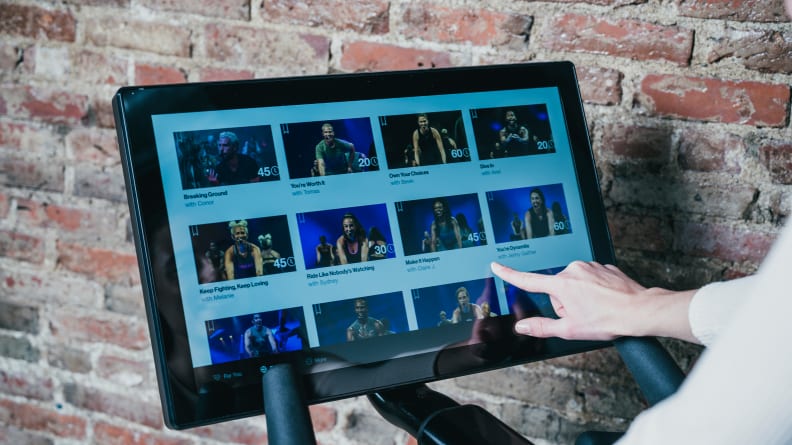
The bike's screen shows you all the different cycling classes you can take, which range from 20 minutes to an hour in length.
I loved the classes and instructors, too. I was a casual SoulCycle fan before I tried the at-home bike (as in, I’d go on my birthday or the rare occasions the studio near me offered class package discounts), so I was familiar with Soul’s combination of loud pop/hip-hop/dance music playlists and vaguely spiritual and/or personal narration from the instructors. If done well, this kind of thing works for me, and for the most part, it’s done well. The most extreme example of inspirational jargon I can remember is an instructor telling the class to clap along with the beat to a song and saying, “Every time you clap a woman in the world gains more confidence”—something that would usually send my eyes straight to the back of my head—but this time, Reader, I clapped. Your mileage may vary.
If you’re choosing between Peloton and SoulCycle, the SoulCycle bike has one clear logistical advantage—you’ll get it a lot faster. Right now, it’ll take at least 10 weeks for the Peloton Bike+ to arrive (and six for the less expensive original bike). Comparatively, the SoulCycle bike has a shipping time between one and three weeks—and, according to members of the SoulCycle subreddit, most new buyers got theirs in about a week.
Finally, a huge pro to the SoulCycle bike, which you won’t find with Peloton or any of the other bikes we tested, is that its tablet lets you stream Netflix and Disney+ with a "free ride" function. You have to have an active account with both services, and you have to have a Variis membership to access the streaming widgets, but it's a big plus if you aren't always motivated by taking a full-on class when you use your bike—and like the idea of using your pedaling time to catch up on "Bridgerton" or "The Mandalorian."
What’s not so good about the SoulCycle bike?

The SoulCycle bike doesn't offer much in the way of metrics.
The bike makes a soft whirring sound when you pedal—you can hear it for yourself here at the 14-second mark. I didn’t find it unpleasant or jarring, but it was a contrast with other bikes in its price bracket, which are much quieter.
The $40-monthly Variis app gives you access to off-bike exercise classes, a common offering among it competition. I liked the available selection of classes, some of which are from Equinox’s in-house brands Pure Yoga and Precision Run and others are from third-party studios, like Rumble Boxing and TB12. However, you can only access these classes on the app using your own separate device, not via the bike’s screen. When I was testing it, I couldn’t access the app from my MacBook, and it didn’t suit the aspect ratio on an iPad. Therefore, I had to take the classes from my iPhone—fine for short ab classes where instructions were straightforward and I didn’t need to check my form much, but not as great for longer yoga classes, where the small screen made the visual instructions harder to see. You can also cast it to your TV if you have Chromecast or an Apple TV—I don’t, so I wasn’t able to try that out.
Finally, the SoulCycle bike’s screen does not swivel, so, even if the off-bike classes do make their way over there, it would be hard to take them without bumping into the bike. Bikes from Peloton, Myx, and NordicTrack all have screens that turn in pretty much any direction you want, which makes it easier to use the bike as a one-stop exercise shop.
Is the SoulCycle bike worth it?
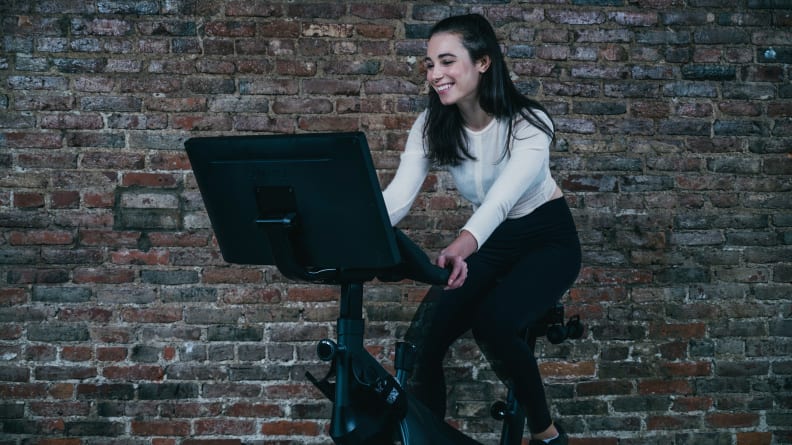
If you know you love SoulCycle, you'll love the at-home bike.
No matter how you slice it, the SoulCycle bike costs a lot of money. If paid in full, the total cost of the first year of ownership is $2,980, plus whatever you spend for cycling shoes ($215, if you get the Soul-branded Pearl Izumi shoes) and/or weights ($18 for Soul's two-pounders and $28 for three-pounders). If dropping $2,500 up front for just the bike is not in the budget, you can finance it with no interest, which comes out to $64.10 a month for 39 months. Either way, you’re committed to a year’s worth of paying the $40 monthly app fee (an additional $480). This total first year cost is comparable to the $2,963 you’d spend for the Peloton Bike+, also $2,500 up front (which may also be financed at $64 per month for 39 months), plus $39 per month for its app membership. For either brand, delivery and assembly is included, and the SoulCycle bike’s warranty covers the display and other components for one year and the frame for five years, with no extension available for purchase. (Peloton's base warranty is the same, but an extension for better protection for the length of the financing period costs $230.)
If you know you love SoulCycle enough to use the bike regularly and know you can’t or don’t want to go to a studio anytime soon, it could be worth it for you, especially if there are others in your household who will use the bike—if you figure you’re spending about $3K on the bike including the first year of membership, that’s approximately 85 in-studio classes (and after that, unlimited classes for unlimited users with the home bike are $40 a month, which is a bargain). As for whether or not it feels like a real SoulCycle class, well, that’s your call—but if you dim the lights and burn a fancy candle, it’ll probably come pretty close.
Get the Soulcycle bike for $2,500 or $64.10 a month for 39 months at 0% APR
The product experts at Reviewed have all your shopping needs covered. Follow Reviewed on Facebook, Twitter, and Instagram for the latest deals, product reviews, and more.
Prices were accurate at the time this article was published but may change over time.
Meet the tester
Sara Hendricks is a former Health and Fitness editor for Reviewed. She has several years of experience reading and writing about lifestyle and wellness topics, with her previous work appearing in Refinery 29, Insider, and The Daily Beast.
Checking our work.
Our team is here to help you buy the best stuff and love what you own. Our writers, editors, and experts obsess over the products we cover to make sure you're confident and satisfied. Have a different opinion about something we recommend? Email us and we'll compare notes.
Shoot us an email